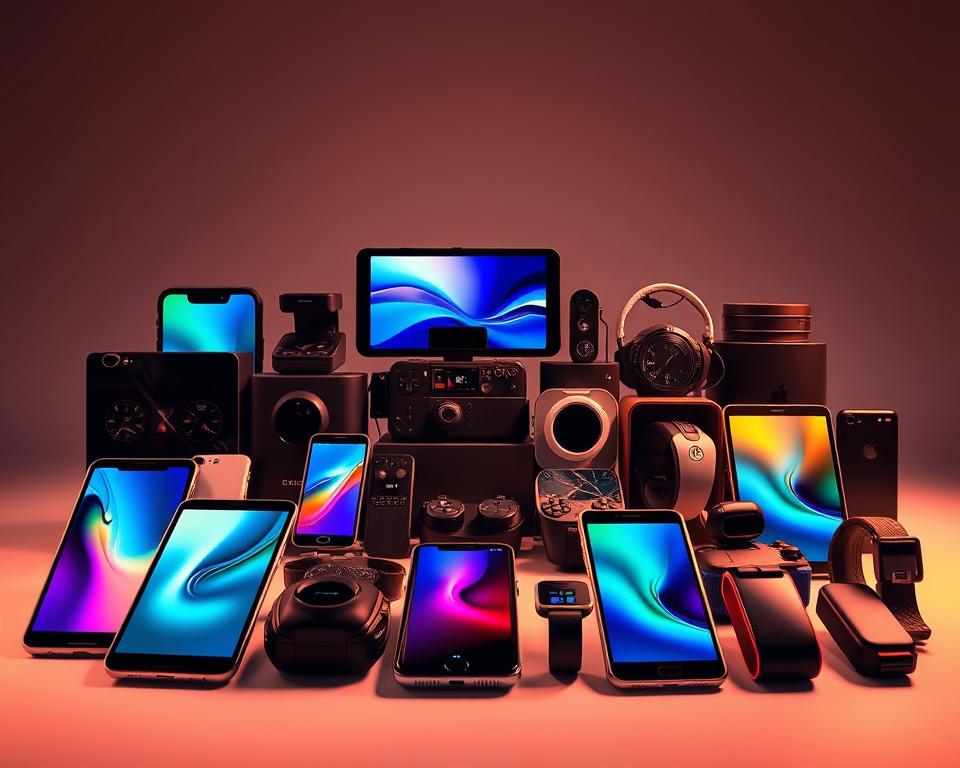
Explore Innovative Mobile Technology Examples
Did you know that over 5 billion people worldwide now use mobile technology? This staggering statistic underscores the pervasiveness of mobile devices in our daily lives, driving an incredible demand for innovative technologies. As mobile applications continue to transform our interactions and experiences, it’s essential to explore how these cutting-edge gadgets are reshaping the way we communicate, learn, and even shop.
From groundbreaking smartphone features to wearable tech that goes beyond fitness, this article delves into the latest mobile technology examples making waves today. Join us as we uncover the innovations that redefine our daily routines and revolutionize user experience.

Key Takeaways
- Mobile technology connects over 5 billion people globally.
- Innovative technologies are transforming daily life.
- The latest mobile applications enhance user engagement.
- Smartphones feature advanced tools that drive change.
- Wearable tech expands capabilities beyond just fitness.
Introduction to Mobile Technology Innovations
The landscape of mobile technology is evolving rapidly with numerous innovations that redefine user experience. An effective introduction to mobile technology reveals how recent tech advancements have improved connectivity and functionality. Mobile devices now come equipped with cutting-edge hardware and software that enhance performance and usability.
These mobile technology innovations allow for seamless integration into daily life, promoting efficiency and convenience. For instance, advancements in battery technology and processing power significantly impact how users engage with their devices. As companies continue to push boundaries, understanding these shifts in technology provides valuable insight into what the future holds for mobile users.

Latest Mobile Applications Revolutionizing User Experience
The landscape of mobile applications continues to evolve, showcasing the latest mobile applications that transform everyday tasks into seamless experiences. Innovative products like Notion and Todoist exemplify how user-centric designs enhance productivity and streamline workflows. With a focus on customization, these apps cater to individual needs, enabling users to organize information effectively.
In addition to productivity, the health and wellness sector is experiencing significant changes through mobile innovations. Applications such as MyFitnessPal and Calm have gained popularity for their tailored offerings that promote wellness and mindfulness. Users can track their fitness goals or enjoy guided meditation, enhancing their overall user experience.
Emerging trends in app features play a vital role in shaping interactions. Push notifications ensure users stay informed, while AI-driven recommendations personalize content further. As app trends shift toward greater interactivity, developers are prioritizing features that foster user engagement and satisfaction.

Mobile Technology Examples that Transform Daily Life
Mobile technology is a driving force behind the transformation of our daily lives. Useful apps enable users to streamline tasks and enhance interactions, making them vital components of modern living. For example, mobile banking applications simplify money management, allowing users to perform transactions conveniently from anywhere. This daily life transformation has made finances more accessible and efficient for countless individuals.
Another noteworthy mobile technology example is smart grocery shopping through apps like Instacart, which revolutionizes how families gather their necessities. With just a few taps, users can create shopping lists, browse local stores, and schedule deliveries right to their doorstep. This innovation saves time, reducing trips to the grocery store, and creating a seamless grocery-buying experience.
Ride-sharing services such as Uber and Lyft redefine transportation, offering convenient alternatives to traditional taxi services. Users can easily summon a ride with their smartphones, enhancing mobility and flexibility in daily routines. The ability to travel on-demand redefines commuting, adapting to users’ schedules and preferences.

As smart homes become increasingly popular, applications for controlling lights, thermostats, and security systems from mobile devices illustrate further daily life transformation. These mobile technology examples not only contribute to energy efficiency but also enhance comfort and safety at home.
Overall, the impact of mobile technology on daily activities cannot be overstated. From managing finances to grocery shopping and transportation, several useful apps shape how individuals navigate their busy lives. Embracing these innovations leads to significant improvements in efficiency and convenience, highlighting the profound effects of mobile technology on our everyday experiences.
Smartphone Innovations: Features Driving Change
The landscape of smartphone innovations continues to evolve at a rapid pace, introducing features that dramatically enhance user experience. Foldable screens, seen in devices such as the Samsung Galaxy Z Fold, redefine portability and usability, allowing users to enjoy larger displays in a compact form. This technology advancement signifies a shift in how consumers interact with their devices.
Another critical area of improvement lies in camera technology. Google’s Pixel Night Sight exemplifies how breakthroughs in imaging software can elevate photography, particularly in low-light conditions. These smartphone innovations bring professional-quality images to everyday users, making photography more accessible and enjoyable.
Battery efficiency remains a focal point of development. Manufacturers are striving to create longer-lasting batteries that support the demanding applications used daily. Improved charging technology allows users to spend less time tethered to power outlets, enhancing overall convenience.
Moreover, seamless software integration plays a pivotal role in enhancing user interface experiences. Enhanced interfaces provide smoother transitions and more intuitive navigation, making smartphones not just tools, but extensions of personal and professional lives.

Wearable Technology Advancements: Beyond Fitness Tracking
Wearable technology advancements have transformed the landscape of personal health and fitness monitoring. Smartwatches like the Apple Watch and Fitbit serve not only as timepieces but as comprehensive health monitoring devices. These gadgets offer features such as ECG readings and blood oxygen tracking, making them invaluable tools for users keen on understanding their health better.
The integration of smartwatches into healthcare systems marks a significant trend in wearable technology. By providing real-time data, these devices assist in chronic disease management and foster proactive healthcare practices. As users gather insights from their health monitoring, the perception of fitness and wellness significantly shifts, emphasizing preventive care over reactive measures.
The following table illustrates key features of popular smartwatches, highlighting their role in promoting health awareness:
| Smartwatch Model | Key Feature | Health Monitoring Capability |
|---|---|---|
| Apple Watch Series 8 | ECG monitor | Tracks heart rhythm anomalies |
| Fitbit Sense | Stress management tools | Provides heart rate variability insights |
| Garmin Venu 2 | Body Battery monitoring | Assesses energy levels throughout the day |
| Samsung Galaxy Watch 4 | Blood oxygen monitoring | Measures SpO2 levels during activities |
This technological progression signifies that wearable devices now function beyond fitness tracking, bridging the gap between technology and healthcare. With continual innovation, users can expect even more enhanced capabilities, ensuring their health remains a priority in their daily lives.
Cutting-Edge Mobile Gadgets to Watch
As technology continues to evolve, cutting-edge mobile gadgets capture our attention with their groundbreaking features and functionalities. Among the remarkable offerings are augmented reality glasses that blend the digital world with reality, enhancing how users interact with their environment. Brands like Microsoft and Google are leading the charge in making augmented experiences accessible to the average user.
Another category of tech gadgets that have gained immense popularity is wireless earbuds. Devices from Apple, such as the AirPods Pro, provide seamless integration with smartphones while delivering superior sound quality. These aren’t just for listening; they incorporate smart technology to understand voice commands, allowing for hands-free operation.
Additionally, innovative devices like smart home hubs, such as the Google Nest, are transforming everyday living. These gadgets connect and control various household devices, offering unparalleled convenience. Users can manage lighting, security, and appliances all from their mobile devices, thereby enhancing their overall lifestyle.
These cutting-edge mobile gadgets illustrate the ongoing progress in technology. Users benefit from their innovative features, which contribute to enhanced experiences in both personal and professional realms. Keeping an eye on these developments promises a future filled with exciting possibilities in mobile technology.
Mobile Device Trends in 2023: What’s Hot Right Now
The landscape of mobile device trends 2023 showcases remarkable shifts driven by consumer preferences for sustainability and tech innovations. Eco-conscious technology emerges as a key focus, with manufacturers prioritizing sustainable materials and energy-efficient designs. This shift reflects a growing awareness of environmental impact among consumers, affecting purchasing decisions.
Another significant trend is the democratization of 5G technology. As more devices support high-speed connectivity, consumers experience enhanced performance and access to advanced applications. With 5G becoming increasingly mainstream, it reshapes how users interact with mobile technology daily.
Artificial Intelligence integrates more deeply into smartphones. Current innovations emphasize smarter assistants that learn user habits, making daily tasks more manageable. This includes improved camera functionalities and advanced personalization in mobile applications.
Embracing these mobile device trends allows manufacturers to cater to the evolving demands of tech-savvy consumers. As the year progresses, staying abreast of these trends becomes essential for anyone engaged in the tech landscape.
Futuristic Mobile Technologies: A Glimpse into the Future
As the world embraces futuristic mobile technologies, the landscape of communication and interaction rapidly evolves. Innovations such as holographic displays promise remarkable visual experiences, transforming how users engage with their devices. In the realm of artificial intelligence, AI-powered personal assistants are becoming increasingly sophisticated, offering personalized support and enhancing daily productivity.
The technology future appears bright with the potential for even more advanced applications. Imagine mobile devices employing augmented reality to seamlessly integrate digital information into everyday tasks. This capability could revolutionize navigation, shopping, and even remote collaboration, making interactions more immersive and intuitive.
Emerging tech will likely lead to a future where mobile devices autonomously manage user preferences. Features such as automated scheduling, context-aware notifications, and real-time decision-making could enhance efficiency and user satisfaction. As these futuristic mobile technologies develop, they will play a crucial role in defining how society interacts with technology on a daily basis.
Mobile Tech Industry Updates: Staying Ahead of the Curve
The mobile tech industry experiences continuous evolution, showcasing intriguing developments that shape future strategies. Companies like Apple and Samsung are central players, consistently adapting their approaches to align with shifting consumer behaviors. Regular updates on significant market trends reflect the dynamic landscape, revealing how these tech giants respond to emerging challenges.
Recent mobile tech industry updates highlight various mergers and acquisitions that illustrate consolidation efforts. New entrants into the market pose fresh competition, contributing to a vibrant ecosystem. Insights into consumer behavior demonstrate a growing preference for innovative features and sustainable practices, allowing companies to stay relevant in a crowded field.
Supply chain issues continue to influence production timelines and pricing structures. Major brands are exploring alternative sourcing strategies to mitigate these risks. Gaining a comprehensive understanding of industry insights equips stakeholders with the necessary tools to navigate the complexities of this fast-paced environment.
How Augmented Reality is Shaping Mobile App Development
Augmented reality is significantly influencing mobile app development by offering users transformative experiences. Projects like Pokémon GO have demonstrated how AR applications can capture audience attention, combining gaming with real-world environments. Users can interact dynamically with their surroundings, blurring the lines between digital and physical realms.
In the retail sector, apps such as IKEA Place utilize augmented reality to allow customers to visualize furniture in their homes before purchasing. This innovative feature enhances user engagement and helps consumers make informed decisions. The ability to picture products within their space has revolutionized how people shop, effectively merging convenience with interactivity.
Emerging features in AR technology include virtual try-ons, where users can see clothing or accessories on themselves without physical items. Such functionality offers incredible utility for businesses and users alike, creating an engaging shopping experience. Navigation tools powered by augmented reality turn everyday commuting into an interactive journey, guiding users effectively through unfamiliar environments.
| AR Application | Industry | Key Feature |
|---|---|---|
| Pokémon GO | Gaming | Real-world interaction with digital creatures. |
| IKEA Place | Retail | Visualizing furniture in real-life settings. |
| Modiface | Beauty | Virtual try-on for cosmetics. |
| Google Maps AR | Navigation | Interactive real-time navigation assistance. |
As augmented reality continues to evolve, its role in mobile app development will likely expand. This technology not only enhances user interactions but also promises to reshape various industries, making applications more immersive and user-friendly.
Mobile Payment Solutions: The Future of Transactions
Mobile payment solutions are transforming the landscape of financial technology, making everyday transactions more efficient and secure. With platforms like Apple Pay and Google Wallet, users can engage in quick, contactless payments. This trend has taken off as people increasingly rely on their smartphones for everyday financial interactions. Consumers appreciate the ability to conduct transactions with just a tap, eliminating the need for cash or physical cards.
The integration of cryptocurrency payment acceptance marks a significant evolution in mobile payment solutions. As digital currencies gain popularity, businesses are beginning to adopt these currencies as viable payment methods, appealing to tech-savvy customers. This shift reflects a broader acceptance of various financial technology advancements that cater to diverse consumer needs.
Security remains a paramount concern in mobile transactions. Innovations in biometric authentication, such as fingerprint scanning and facial recognition, are enhancing user trust. These measures ensure that personal and financial information remains protected, fostering a sense of confidence in using mobile payment solutions for daily transactions. As the world continues to embrace these technologies, we can anticipate even more enhancements in the convenience and safety of mobile financial interactions.
The Rise of 5G: Impact on Mobile Technology
The rise of 5G technology marks a significant evolution in mobile connectivity, transforming how industries and consumers experience mobile technology. Faster download speeds and lower latency are just two of the benefits that enhance daily activities, from gaming to video streaming.
With the implementation of 5G, users can expect connectivity advancements that simplify their lives in numerous ways. Various applications ranging from real-time collaborations to immersive 4K video streaming will flourish. The shift enables smoother interactions and almost instantaneous communication, addressing previous limitations in mobile technology.
The mobile technology impact extends beyond personal use. The integration of 5G in Internet of Things (IoT) devices paves the way for smart cities, where everything from traffic management to energy consumption can be optimized. Businesses leverage this technology to innovate, creating new applications and services that reach consumers in imaginative ways.
As the landscape of mobile technology evolves, the rise of 5G will continue to play a crucial role in shaping a more connected world, producing opportunities that align with the ever-changing needs of society. Companies that adopt this technology can enhance their offerings, ensuring that they remain competitive in a rapidly evolving market.
Artificial Intelligence in Mobile Apps: Enhancing User Interaction
Artificial intelligence in apps has transformed the way users interact with their mobile devices. This technology allows applications to learn from user behavior, creating a more personalized experience. For instance, streaming services like Netflix and Spotify effectively utilize AI to recommend content that aligns with users’ preferences, enhancing engagement and satisfaction.
Machine learning plays a significant role in providing real-time enhancements within apps. Functions such as image recognition in social media platforms have been improved, allowing users to easily tag friends or add filters to their photos. These app enhancements not only streamline the user experience but also encourage interaction and participation.
Another area where artificial intelligence excels is in language processing. Apps that offer real-time translation services have become invaluable for users traveling or dealing with multilingual environments. Users can interact seamlessly, breaking down language barriers and fostering communication. As AI technology continues to evolve, its influence on user interaction will only grow stronger.
The continuous advancement of AI technologies creates positive feedback loops within user experience. Developers who harness these capabilities not only improve app functionalities but also build user loyalty through satisfying and engaging interactions.
| App | AI Functionality | Enhancement Type |
|---|---|---|
| Netflix | Personalized Recommendations | User Interaction |
| Spotify | Music Recommendation Algorithms | User Interaction |
| Google Photos | Image Recognition | App Enhancements |
| Duolingo | Real-Time Language Processing | User Interaction |
Mobile Security Innovations: Protecting Your Data
As the world becomes increasingly digital, mobile security innovations play a critical role in ensuring data protection. With the proliferation of smartphones and tablets, the need for robust cybersecurity measures has never been more apparent. Users today face numerous threats, ranging from data breaches to malicious software targeting mobile devices.
One of the leading advancements in mobile security is biometric authentication. Technologies like fingerprint scanners and facial recognition offer a convenient yet secure way to access devices. These innovations not only enhance user experience but also significantly improve data protection by making unauthorized access nearly impossible.
Encryption methods have also evolved, safeguarding sensitive information stored on mobile devices. Advanced algorithms protect user data, ensuring that even if a device falls into the wrong hands, the information remains secure. This layer of cybersecurity is vital for users who store personal, financial, or confidential data on their smartphones.
The mobile security landscape continues to evolve in response to emerging threats. Cybersecurity experts actively monitor trends to develop strategies that counteract potential risks, ensuring that data protection measures are effective and up-to-date. As innovative technologies emerge, users can feel more confident in the safety of their devices, knowing that dedicated efforts are in place to address vulnerabilities.
Mobile Technology Examples in Education: Learning on-the-Go
Mobile technology in education has transformed traditional learning environments, empowering students to engage deeply with their studies from anywhere. Applications such as Duolingo and Khan Academy exemplify how learning apps enhance the educational experience. These platforms offer interactive and personalized learning paths, making education more accessible and enjoyable.
One significant benefit of educational tech is its ability to support remote learning. Students can access a wealth of resources at their fingertips, allowing for flexibility and self-paced study. The incorporation of augmented reality (AR) and virtual reality (VR) holds immense potential for immersing learners in their subjects, offering engaging simulations that enrich understanding.
| Learning App | Features | Target Audience | Purpose |
|---|---|---|---|
| Duolingo | Gamified language learning, interactive speaking exercises | Language learners of all ages | Learn new languages through engaging methods |
| Khan Academy | Video tutorials, practice exercises, personalized dashboard | Students from K-12 to college | Comprehensive learning across subjects |
| Google Classroom | Assignment management, collaboration tools, communication platform | Teachers and students | Facilitating classroom management and remote learning |
| Quizlet | Study sets, flashcards, interactive quizzes | Students preparing for exams | Enhancing study and revision techniques |
This integration of mobile technology in education empowers learners to pursue knowledge on their terms, revolutionizing how education is perceived and delivered. Through these innovative tools, students become active participants in their educational journeys, leading to greater retention and understanding of complex subjects.
Connecting Communities: Mobile Tech’s Role in Social Change
Mobile tech and social change have become intertwined, fostering community connection in ways never seen before. Popular platforms such as WhatsApp and various social media channels enable individuals to organize, advocate, and share vital information with ease. They serve as critical tools during emergencies, whether during natural disasters or public health crises.
Mobile technology’s impact on community activism illustrates its power. Case studies highlight how these platforms empower local groups to mobilize resources, share updates, and connect individuals in need. For example, during Hurricane Harvey, residents utilized social media to link people with shelter, food, and assistance efficiently.
This technology fosters a sense of belonging and collective action, nurturing grassroots movements. With just a few clicks, people can initiate campaigns, spread awareness, and garner support for local issues. The technology impact extends beyond communication, as it encourages community members to engage with each other in meaningful ways, strengthening bonds and enhancing societal resilience.
Conclusion
In summation, the exploration of mobile technology highlights its profound technological impact on our everyday lives. From innovative applications that reshape user experiences to wearable technologies that extend beyond fitness tracking, the examples discussed underscore how deeply integrated mobile devices have become in personal, professional, and social spheres. As we look toward the future outlook of mobile tech, it is clear that the dynamics of connectivity and user interaction will continue to evolve rapidly.
This article has illustrated the broad spectrum of mobile technology innovations, emphasizing not just their functionality but their role in fostering community connections and transforming daily routines. Each advancement, whether it’s augmented reality or mobile payment solutions, showcases the ongoing evolution that stands to redefine our engagement with technology.
As the landscape of mobile technology continues to shift, readers are encouraged to remain informed about emerging trends and innovations. Staying updated on the latest developments will empower individuals and businesses alike to harness the capabilities of mobile technology, ensuring they are well-prepared for what lies ahead. Embracing this conclusion on mobile technology invites anticipation for a more interconnected and technologically sophisticated future.



